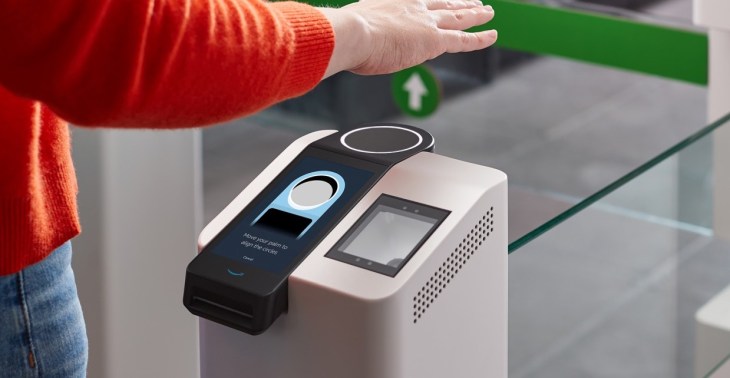Usuarios del Club TRPlane
Durante la pandemia, cuando los clientes usaban guantes de plástico para ir a las tiendas junto con sus mascarillas, el equipo minorista físico de Amazon presentó un nuevo dispositivo biométrico que permite a los compradores pagar en las tiendas Amazon Go con la palma de su mano. La compañía Amazon One supuestamente «sin contacto», una especie de escáner en el que primero se inserta la tarjeta de crédito y luego pasará la palma de la mano sobre el dispositivo para asociar la firma de la palma con su mecanismo de pago. Una vez que la tarjeta esté guardada, puede entrar en la tienda en el futuro simplemente manteniendo la palma de la mano sobre el dispositivo Amazon One durante un segundo más o menos.

Si bien se supone que no se debe presionar con la palma de la mano sobre el dispositivo en sí, es una nueva tecnología que requiere educación del usuario, y eso podría ser un problema, al menos a corto plazo.
Hoy en día, los consumidores están familiarizados con la idea de presionar un dedo para desbloquear un iPhone con Touch ID, por ejemplo, o usar una huella digital para abrir un candado seguro. Es probable que muchos supongan que también se debe poner la palma de la mano sobre la superficie plana de Amazon One.
En cualquier otro momento, eso no sería una gran preocupación. Pero dado que el dispositivo se está introduciendo en los Estados Unidos, que todavía está lidiando con la crisis de COVID-19, ahora puede no ser el mejor momento para poner otro punto de contacto potencial en la entrada de una tienda.
Amazon, por supuesto, enfatiza que el dispositivo es «sin contacto», algo que los clientes apreciarán. Pero a menos que el personal de la tienda esté en la entrada limpiando el dispositivo con regularidad, es probable que se toque mucho a medida que los clientes se familiaricen con el funcionamiento exacto. Eventualmente, Amazon One puede lograr el objetivo de ser «sin contacto». Pero mientras tanto, el dispositivo debe tener personal, limpiarse y mostrarse a todos los que entren.
Amazon dice que el nuevo dispositivo utiliza tecnología de visión por computadora en tiempo real para crear la firma única de la palma de la mano, una elección que hizo la compañía porque cree que el reconocimiento de la palma de la mano es más privado que otros medios de autenticación biométrica. Es decir, no puedes determinar la identidad de alguien con solo mirar la imagen de su palma, dice Amazon. Eso puede ser cierto, pero dado que la firma de la palma está asociada con una tarjeta de pago, es más importante que los datos estén seguros que cuán reconocible es la imagen de la palma.
Amazon también dice que las imágenes se cifran y se envían a un área segura en la nube, donde se crean las firmas de palma de los clientes. No hay más detalles específicos sobre este proceso.
Sin embargo, el uso histórico de productos biométricos por parte de Amazon también ha sido controvertido, ya que vendió servicios de reconocimiento facial biométrico a las fuerzas del orden en USA. Su tecnología de reconocimiento facial también es objeto de una demanda por privacidad de datos. Recientemente, lanzó drones de interior para la seguridad del hogar, en una nueva amenaza potencial para la privacidad de los propietarios. En términos de privacidad de los datos de los usuarios, Amazon tampoco ha tenido cuidado, por ejemplo, al continuar almacenando los datos de voz de Alexa incluso cuando los usuarios eliminaron los archivos de audio.
Esta situación genera un espacio para cuestionar los planes de Amazon acerca de crear una base de datos de datos biométricos de los clientes.
Amazon dice que su nuevo dispositivo no requiere que tenga una cuenta de Amazon.com para ingresar a la tienda, solo una palma y un número de teléfono, pero los clientes pueden asociar su cuenta para ver su historial de uso en el sitio web de Amazon. También pueden agregar una segunda huella de la palma, si quieren.
El Amazon One se está probando en dos tiendas del área de Seattle, incluida la tienda Amazon Go original en 7th & Blanchard y la tienda en South Lake Union en 300 Boren Ave. North. Sin embargo, no reemplazará las otras formas de entrada a las tiendas. Los clientes aún pueden ingresar usando la aplicación Amazon Go, la aplicación Amazon o en efectivo a un vendedor de la tienda.
El Amazon One no tiene que usarse solo para entrar en tiendas minoristas, señala la compañía. Prevé que el dispositivo sea utilizado por terceros, incluidos estadios y edificios de oficinas, así como otros minoristas que no son de Amazon.
Amazon dice que se están llevando a cabo conversaciones con algunas partes interesadas, pero no anticipa nada en este momento. Sin embargo, no está claro en qué medida un minorista externo confiaría en Amazon para alojar los datos de transacciones de sus clientes, dado el historial de Amazon en el uso de datos de terceros de manera anticompetitiva.

